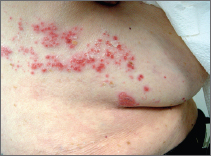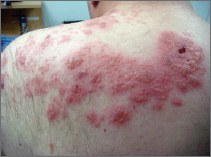Herpes zoster (shingles) is caused by varicella-zoster virus (VZV), which is the same virus that causes varicella (chickenpox). VZV first occurs as chickenpox, which is usually seen in childhood; later it returns as herpes zoster, caused by reactivation of the same virus.
Reactivation as shingles may be associated with illness or occur with no obvious cause.
Herpes zoster
Why is it sometimes so painful?
The pain of herpes zoster is thought to be a result of the nerve damage caused by the virus spreading to the skin.
Usually blisters occur in a characteristic pattern that “wraps” around one side of the body.
Although herpes zoster can affect any area of the body, it is most commonly found on the side of the chest, on one side of the face, on the lower back, or on an arm or a leg.
Sometimes there can be eye involvement. This may pose a risk to vision and must be promptly evaluated and treated.
Herpes zoster
Pain control is generally the main concern.
A progressing herpes zoster eruption is often treated with antiviral drugs. Valacyclovir (Valtrex), famciclovir (Famvir), and acyclovir are all most effective when given within 72 hours of the appearance of the zoster rash. These drugs have very few side effects.
Oral corticosteroids are sometimes used in combination with oral antiviral drugs for severe infections.
Burow's solution is a soothing astringent preparation that helps dry up and control weeping, oozing, and infected skin.
How do I use Burow's solution?
Dissolve one packet or tablet in an 8-ounce glass of cool or lukewarm water.
Make a wet compress using a cloth or cotton swab moistened by the solution and leave it in place for 15 to 20 minutes. Do this three to four times each day.
Discontinue the soaks when the oozing and any signs of infection have disappeared.
Over-the-counter pain medications, such as aspirin, acetaminophen (Tylenol), and nonsteroidal anti-inflammatory drugs such as Motrin, Advil, and Aleve are helpful in mild, self-limited cases.
A topical ointment, Zostrix, which contains capsaicin, an extract of pepper, sometimes helps control the pain. This ointment can be obtained without a prescription.
If the pain is not controlled by these measures, prescription-strength medication may be necessary. Discuss this with your health care provider.
Postherpetic neuralgia (PHN) is defined as pain persisting for more than 1 month after the rash of the initial herpes zoster lesions.
Patients with herpes zoster can transmit VZV as chickenpox to people who have not already been infected with the virus.
Is there any way to prevent it?
A VZV vaccine (Zostavax) is now available. There appears to be a significant reduction in the appearance and severity of herpes zoster and PHN in people who are inoculated.
The vaccine is recommended for people older than 60 years of age.
The vaccine is not for everyone, and you should discuss it with your health care provider.
Outline


